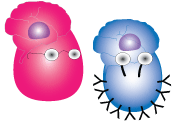
B cell activation
In the last page we said that to become activated, naïve B cells first need intact antigen to cross-link their surface Ig and this happens in the T cell zone of the lymph node as they are making their way to the B cell follicles. Watch how the B cells migrate and interact with other cells during its activation process in this video.

In the video we saw how B cells arrived in the lymph node and interacted with activated Th cells that caused the B cells to start to proliferate and produce antibodies. But the video did not explain how all this really happened, which is why we will now use the picture to help us grasp three key events during B cell activation; phosphorylation, CD40:CD40L interaction and Th cell cytokines. Just like we saw with T cells, B cell activation does not only involve the molecule with antigen specificity, which in this case is the Ig. In B cells the Ig makes a complex with CD79a and CD79b, and together these molecules are referred to as the B cell receptor (BCR). Antigen binding to Ig provides the first activation signal which causes another group of molecules to help the BCR turn on many phosphorylation pathways within the B cell. This causes the display of more MHC class II molecules and costimulatory molecules, like CD80, CD86 and CD40, on the surface of the B cell. The antigen:Ig complexes are at the same time taken inside the B cell where the antigen is chopped up and fragments loaded onto MHC class II molecules, which we saw in the video on the introduction page. Most B cell responses to protein antigens then require interaction with activated Th cells as we saw in the video above, and the reason is that activated Th cells express a surface molecule called CD40 ligand (CD40L) which interacts with CD40 on the B cell providing a very important second survival signal. At the same time, the B cell expressed CD80 and CD86 further stimulates the Th cell, via CD28, to release cytokines like IL-2, IL-4 and IL-5. These cytokines both act on nearby Th cells and B cells, and the consequences of this will become apparent in the next few pages where we look at antibody production. The fully activated B cell now proliferates making a large clone, a portion of which becomes antibody producing plasma cells. Let's find out more about these cells on the next page.